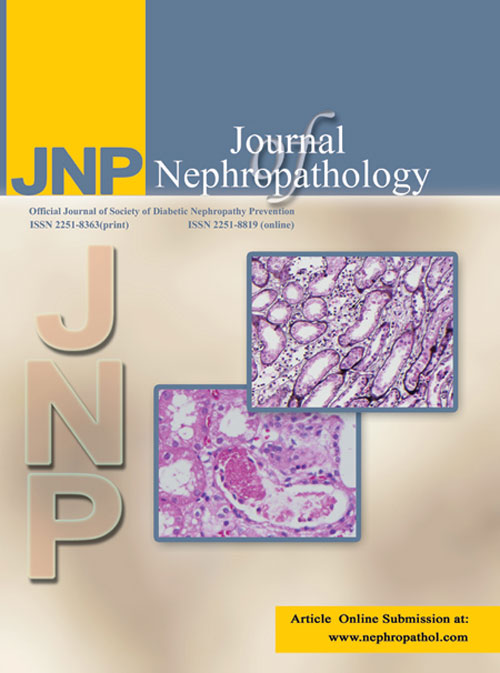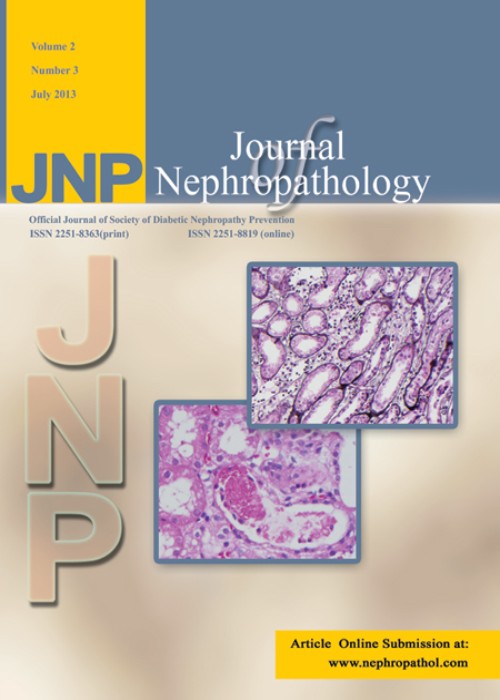فهرست مطالب

Journal of nephropathology
Volume:4 Issue: 3, Jul 2015
- تاریخ انتشار: 1394/04/16
- تعداد عناوین: 8
-
Pages 62-68BackgroundAngiotensin converting enzyme (ACE) is involved in various pathophysiological conditions including renal function. ACE levels are under genetic control.ObjectivesThis study was designed to investigate the association between the donors and recipients ACE-I/D gene polymorphism and risk of acute rejection outcome in renal allograft recipients. Patients andMethodsACE-I/D polymorphism was determined in 200 donor-recipient pairs who had been referred to Afzalipour hospital in Kerman. ACE-I/D polymorphism was detected using polymerase chain reaction (PCR). Acute rejection (AR) during at least six months post-transplantation was defined as a 20% increase in creatinine level from the postoperative baseline in the absence of other causes of graft dysfunction which responded to antirejection therapy.ResultsThe observed allele frequencies were II 9.8%, ID 35.6% and DD 44.4% in donors and II 9.8%, ID 35.1% and DD 52.7% in recipients. There were no significant association between ACE genotypes and AR episodes (ORID=0.96 [0.18-5.00] and ORDD: 1.24 [0.25-6.07] for the donors) and (ORID: 0.29 [0.06-1.45] and ORDD: 0.75 [0.19-2.90] for the recipients).ConclusionsIt seems that donor and recipient ACE-I/D genotype might not be a risk factor for acute renal allograft rejection. However, due to conflicting results from this and other studies, multicenter collaborative studies with more participants and concomitant evaluation of ACE polymorphism with other polymorphisms in renin–angiotensin system (RAS) are suggested to determine whether ACE genotypes are significant predictors of renal allograft rejection.Keywords: Angiotensin, converting, enzyme, Gen polymorphism, Acute rejection, Kidney transplant
-
Pages 69-76BackgroundThere are inconsistent reports related to the role of angiotensin II type 1 receptor (AT1R) on the risk of type 2 diabetes mellitus (T2DM) and its renal complications.ObjectivesTo identify the association between AT1R A1166C variants with the risk of T2DM and also with diabetic nephropathy (DN). Patients andMethodsIn a case-control study, the AT1R A1166C polymorphism was detected in 135 T2DM patients with and without DN and in 98 healthy subjects from Western Iran. The genotypes of AT1R A1166C polymorphism were detected using polymerase chain reaction-restriction fragment length polymorphism (PCR-RFLP) method.ResultsThe frequencies of AT1R A1166C genotypes and alleles were not significantly difference between patients with and without DN and controls. The frequencies of rare allele of 1166 C were 10%, 16.5%, 15.9% and 15.3% in micro-, macro- and normo-albuminuric patients and in healthy individuals, respectively (P > 0.05). The systolic blood pressure and serum creatinine level in DN patients were significantly higher in carriers of AT1R CC compared to carriers of AT1R AA genotype. In the presence of uncontrolled hyperglycemia (HbA1c > 7.5%), there was a trend toward increased risk of macro-albuminuria in carriers of AC+CC genotype (OR=3.66, [95% CI: 0.81-16.58], P = 0.092).ConclusionsOur study indicated the absence of an association between AT1R A1166C polymorphism with the risk of T2DM and DN. It seems in carriers of AT1R C allele systolic blood pressure and serum creatinine level to be higher compared to the A allele carriers.Keywords: AT1R A1166C polymorphism_Type 2 diabetes mellitus_Diabetic nephropathy_Macroalbuminuria
-
Pages 77-84BackgroundSeveral studies have shown that there are an increasing in invasive candidiasis during 2-3 last decades. Although, Candida albicans is considered as the most common candidiasis agents, other non-albicans such as C. glabrata, C. krusei, C. parapsilosis, and C. tropicalis were raised as infectious agents. Resistance to fluconazole among non-albicans species is an important problem for clinicians during therapy and prophylaxis.ObjectivesThe aim of current study was to detect the Candida species from hospitalized neonatal and children in intensive care units (ICUs) and neonatal intensive care units (NICUs). In addition, the susceptibility of isolated agents were also evaluated against three antifungals.Materials And MethodsIn the present study 298 samples including 98 blood samples, 100 urines and 100 swabs from oral cavity were inoculated on CHROMagar Candida. Initial detection was done according to the coloration colonies on CHROMagar Candida. Morphology on cornmeal agar, germ tube formation and growth at 45°C were confirmed isolates. Amphotericin B, fluconazole and terbinafine (Lamisil) were used for the susceptibility tests using microdilution method.ResultsIn the present study 21% and 34% of urines and swabs from oral cavity were positive for Candida species, respectively. The most common species was C. albicans (62.5%) followed by C. tropicalis (15.6%), C. glabrata (6.3%) and Candida species (15.6%). Our study indicated that the most tested species of Candida, 70.3% were sensitive to fluconazole at the concentration of ≤8 μg/mL. Whereas 9 (14.1%) of isolates were resistant to amphotericine B at ≥8 μg/mL.ConclusionsThis study demonstrates the importance of species identification and antifungals susceptibility testing for hospitalized patients in ICUs and NICUs wards.Keywords: Candida species, Amphotericin B, Fluconazole, Terbinafine, Minimum inhibitory concentration
-
Pages 85-90BackgroundHigh blood pressure is a common condition in hemodialysis patients. Uric acid, which is high in these patients due to decreased clearance, had been shown to positively correlate with blood pressure in animal studies.ObjectivesThe goal of this investigation was to evaluate the impact of high uric acid level on blood pressure in these patients.Patients andMethodsNinety-one patients, on three times weekly hemodialysis, were studied. Uric acid levels were measured just before and after hemodialysis along with blood pressures before, during and after each session. Data were analyzed by SPSS 15. A P value less than 0.05 was considered significant.Results40 (44%) of patients had serum uric acid ≥6 mg/dl. Before dialysis 51 (61%) and 19 (21%) had high systolic blood and diastolic blood pressures respectively. Also, 50 (55%) were with wide pulse pressure and 63 (69%) had high mean arterial pressure (MAP). Additionally 62 (68%) developed inter-dialysis hypotension. After measuring odds ratio for hyperuricemia in each group, we observed low risk of hypruricemia in the group with high systolic pressure (OR = 0.352; 95% CI: 0.147-0.844; P = 0.01), the high MAP group (OR = 0.382; 95% CI: 0.153-0.955; P = 0.03) and wide pulse pressure group (OR = 0.416; 95% CI: 0.177-0.975; P = 0.04). There was no association between high uric acid level and diastolic pressure (P = 0.11) and inter-dialysis hypotension (P = 0.33). No relationship was found between serum uric acid and KT/V (P = 0.2), normalized protein catabolic rate (nPCR) (P = 0.07) and body mass index (BMI) (P = 0.4).ConclusionsThis study showed paradoxical association between high uric acid level and high systolic pressure, high MAP and wide pulse pressure and these effects were independent of dialysis duration, dialysis efficacy and nutrition, assuming that these relationships could be due to reverse epidemiology in dialysis patients.Keywords: Uric acid, Blood pressure, Hemodialysis
-
Pages 91-96BackgroundThe existence of membranous cytoplasmic bodies in biopsied kidney tissues is one of the important findings when considering Fabry disease as the first choice diagnosis. However, there are possible acquired lysosomal diseases associated with pharmacological toxicity, although less attention has been paid to them.Case PresentationWe experienced 3 male patients presenting with proteinuria and specific pathological changes strongly suggesting Fabry disease. We sought detailed clinical and biochemical information to avoid a wrong diagnosis. The patients were examined clinically and pathologically, and plasma α-galactosidase A (GLA) activity and the globotriaosylsphingosine (lyso-Gb3) concentrations were measured. Electron microscopic examination revealed numerous membranous inclusion bodies in podocytes, and biochemical analysis revealed normal GLA activity and a normal lyso-Gb3 level in plasma, showing that they did not have Fabry disease. They suffered from hyperlipidemia, myeloma, or lupus nephritis. They had received pitavastatin calcium, clarithromycin, loxoprofen and/or prednisolone, and there was no medication history of cationic amphiphilic drugs.ConclusionsIn this case series, the etiology of the inclusions was not clarified. However, these cases indicate that careful attention should be paid on diagnosis of patients exhibiting inclusion bodies in kidney cells, and it is important to confirm their past and present illnesses, and medication history as well as to measure the GLA activity and lyso-Gb3 level.Keywords: Fabry disease, Inclusion body, Acquired lysosomal disease, α, Galactosidase A, Globotriaosylsphingosine
-
Pages 97-100BackgroundHistiocytic sarcoma (HS) is a rare hematologic neoplasm with a few hundred cases having been described to date.Case PresentationWe report the case of a 56-year-old woman with a history of hepatitis C infection and chronic kidney disease (CKD), submitted to a kidney transplant in 1984, under maintenance immunosuppression with prednisone and azathioprine. Patient presented with a relentlessly growing mass on her right front thorax. It was painless, smooth, and adherent to the deep muscle. Laboratory studies were unremarkable. Ultrasonography and computerized tomography (CT) scan revealed a highly vascularized heterogeneous mass (8×9 cm), with a necrotic centre. Positron emission tomography (PET) scan demonstrated multiple thoracic, abdominal, and pelvic nodules. Histology revealed a highly undifferentiated HS (vimentin, CD68, CD99, and CD4 positive). In spite of having started treatment with etoposide and thalidomide, no clinical response was achieved and the patient died three months later.ConclusionsTo the authors’ knowledge, this is the first described case of HS in a solid organ transplant patient.Keywords: Histiocytic sarcoma, Post, transplant lymphoproliferative disease, Malignancy, Transplant, Chronic kidney disease


